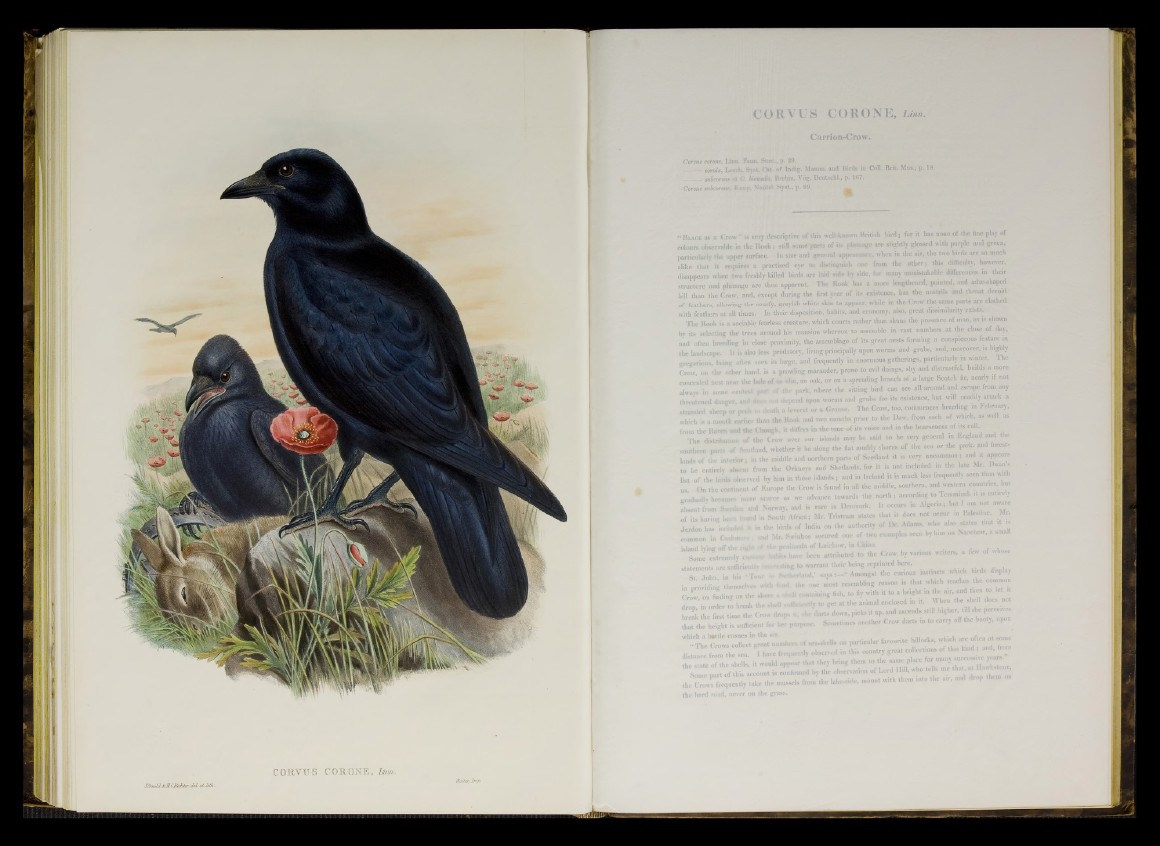
Jtjmdtb¿¡KCHidUa-, deb e t lidi'.
COBTUS CORONE, lira/.
Walter, Imp.
Carrion-Crow.
Corone corone, Lion. Faun. Suec., p. 29.
'' _ comix, liCscU. Syst. Cat. of Indig. Mamra. and Birds in Coll. B rit Mu»., p. 18.
subcovone et C. h iem a iis , Brchm, Vog. Deutschl., p. 167.
Corone subcorom, Kaup, Navitri. Syst., p. 99.
“ B lack as a Crow ” is very descriptive of this welt-known British bird; for it has none of the fine play of
coloors observable in the Kook; still some parts of its plumage are slightly glossed with purple and green,
particularly the upper surface. In size and general appearance, when in the air. the two birds are SO ranch
alike that it requires a practised eye to distinguish one from the other; this difficulty, however,
disappears when two freshly killed birds are laid side by side, for many unmistakable differences m their
structure and plumage are then apparent. The Kook has a more lengthened, pointed, and adze-shaped
bill than the Crow, and, except during the first year of its existence, has the nostrils and throat devoid
of feathers, allowing the scurfy, greyish white skin to appear, while in the Crow the same parts are clothed
with feathers at all times. In their disposition, habits, and economy, also, great dissimilarity exists.
The Kook is a sociable fearless creature, which courts rather than shuns the presence of man, as is shown
by its selecting the trees around his mansion whereon to assemble in vast numbers at the close of day,
and often breeding in close proximity, the assemblage of its great nests forming a conspicuous feature in
the landscape. It is also less predatory, living principally upon worms and grubs, and, moreover, is highly
gregarious, being often seen in large, and frequently in enormous gatherings, particnlarly in winter. The
Crow on the other hand, is a prowling marauder, prone to evil doings, shy and distrustful, builds a more
concealed nest near the hole of an elm, an oak, or on a spreading branch of a large Scotch fir, nearly if not
always in some central pari f the park, where the sitting bird can see all around and escape from any
threatened danger, and does « 0 depend upon worms and grubs for its existence, but will readily attack a
stranded sheep or peek ■ death a leveret or a Grouse. The Crow, too, commences breeding m February,
which is a month earlier than the Kook and two months prior to the Daw. from each of which as well as
from the Raven and the Chough, it differs in the tone of its voice and in the hoarseness of Us call.
The distribution of the Crow over our islands may be said to be very general in Eng and and the
sonthern parts of Scotland, whether it be along the flat muddy shores of the sea or the park- and forest,
lands of the interior ; in the middle and northern parts of Scotland it is very uncommon ; and it appears
to be entirely absent from the Orkneys and Shetlands, for it is not included in the ate Mr Dunns
list of the birds observed by him in those islands; and in Ireland it is much less frequently seen than with
ns On the continent of Europe the Crow is found in all the middle, southern, and western countries, but
dually become» more scarce as we advance towatds the north; according to Temmmck it is entirely
I absent from Sweden and lOu . x.rhorway,Norway, ¿and mu i •.is n rare hhc m nDenmark,«....nmark ■>——» —------ It it occurs occurs in m Aa lgg « eria;s but _
I am not aw„are
►uth Africa; Mr. Tristram states that it does not occur m Palestine, »1
birds of India on the authority of Dr. Adams, who also states that it
of its having been found in South Africa; Mr. Tristram states that it does not occur in Palestine. Mr.
Jerdon has include» it in the birds of India on the authority of Dr. Adams, who also states that it is
common in Cash.,. . ami Mr. Swinhoe secured one of two example, seen b , him on Naoehow, a small
• .1.,.,! iu:n„ ft<r the r>'.*iii »he peninsula of Luichow, in China.
Some extremely cm * « habits have been attributed to the Crow by various write», a few of whose
statements are curious instincts which birds display
■ „ 2 : 1 'themselves with food the one most resembling reason is that which teaches the common
in pro g ., containing fish, to fly with it to a height in the air, and then to let it
Crow, on find..g ^ g a( J encIosed i„ it. When the shell does not
drop, ill order to , , ‘ . d icks ;t up alld ascends still higher, till she perceives
b r e a k the first time darts in to carey off the booty, upoa
that the height is sufheient for her purjKisc. oomeinue
"'“ h e " m t " g l ' t T n m b e r s ofsea-shells on partieolar favourite hillocks, which are oftea at some
distance from the sea. I have frequently observed in this country great collections of tins kind wind, from
the state of the shells, it would appear that they bring them to the same place
Some part of this account is confirmed by the observation of Lord Hill, who tells me that,
. - , i • i_______* tlxp.m mto the air. and •
¡tone,
——.1 .1 a.,.,, fkx.tn jiii
ri Al-. AaIm *1...